Lifecycle Costing and Risk Management for Water Infrastructure Project
VerifiedAdded on 2020/03/16
|28
|7236
|273
Report
AI Summary
This report delves into the lifecycle and risk management of water infrastructure, specifically focusing on water pipeline networks in Dubai. It begins by identifying the asset, the water pipeline network, and its importance in addressing water scarcity and meeting the growing water demand in Dubai. The report outlines the project's background, objectives, and the role of asset management in ensuring the sustainable operation of the water supply system. It then identifies an approach to life cycle cost analysis, discussing the selection of lifecycle standards, particularly ISO 55001, and the use of Net Present Value (NPV) for cost analysis. The report covers data collection, acquisition, and operational aspects within the ISO 55001 framework. Furthermore, it presents a process diagram illustrating the water supply system, from source to consumer, and highlights the benefits of lifecycle costing, such as reducing risks, improving quality assurance, and aligning engineering decisions with business objectives. The report uses the LICAN model to estimate operational costs and concludes by emphasizing the importance of lifecycle costing in making informed decisions related to asset management and sustainable water use.

Running head: LIFECYCLE AND RISK MANAGEMENT
Lifecycle and Risk Management
Name of the Student:
Name of the University:
Lifecycle and Risk Management
Name of the Student:
Name of the University:
Paraphrase This Document
Need a fresh take? Get an instant paraphrase of this document with our AI Paraphraser
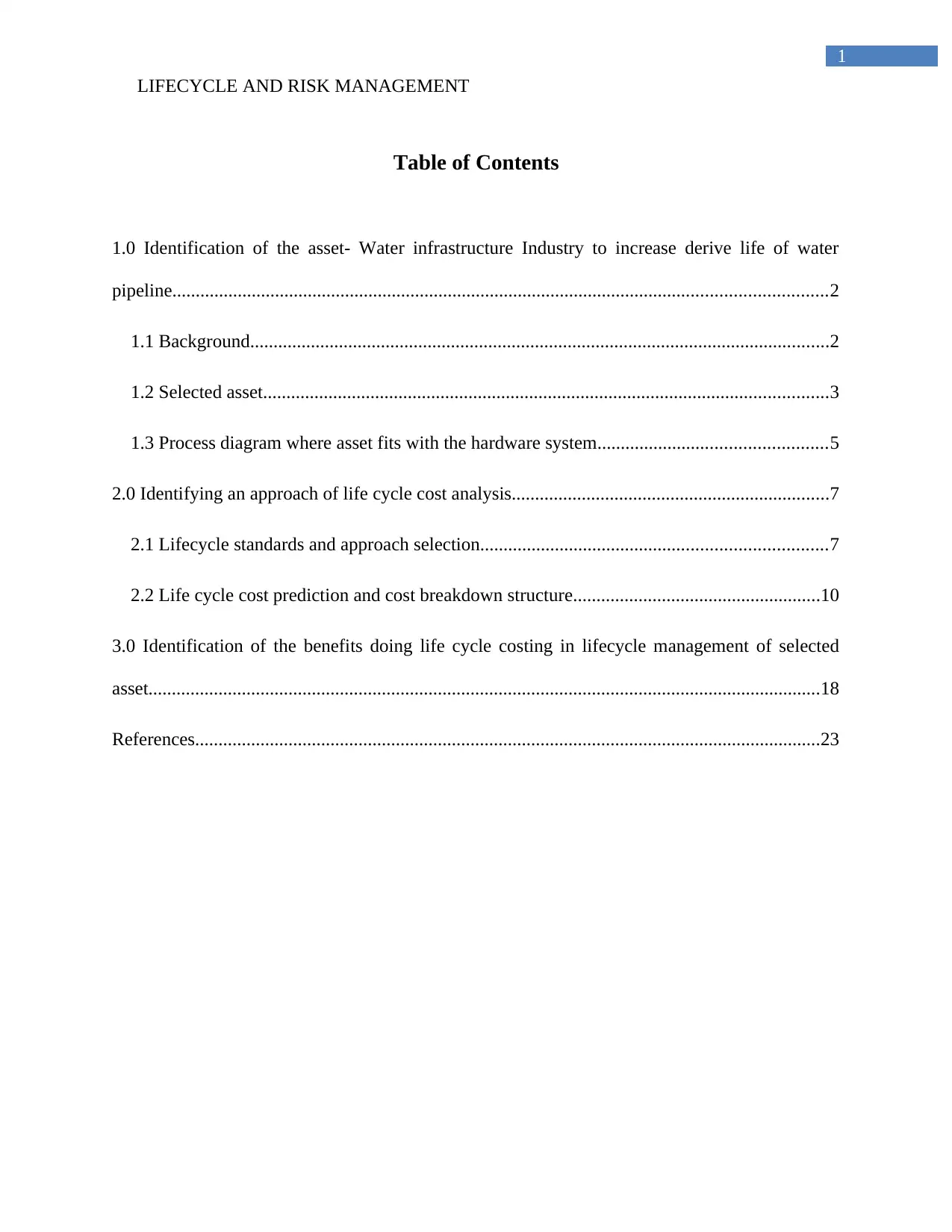
1
LIFECYCLE AND RISK MANAGEMENT
Table of Contents
1.0 Identification of the asset- Water infrastructure Industry to increase derive life of water
pipeline............................................................................................................................................2
1.1 Background............................................................................................................................2
1.2 Selected asset.........................................................................................................................3
1.3 Process diagram where asset fits with the hardware system.................................................5
2.0 Identifying an approach of life cycle cost analysis....................................................................7
2.1 Lifecycle standards and approach selection..........................................................................7
2.2 Life cycle cost prediction and cost breakdown structure.....................................................10
3.0 Identification of the benefits doing life cycle costing in lifecycle management of selected
asset................................................................................................................................................18
References......................................................................................................................................23
LIFECYCLE AND RISK MANAGEMENT
Table of Contents
1.0 Identification of the asset- Water infrastructure Industry to increase derive life of water
pipeline............................................................................................................................................2
1.1 Background............................................................................................................................2
1.2 Selected asset.........................................................................................................................3
1.3 Process diagram where asset fits with the hardware system.................................................5
2.0 Identifying an approach of life cycle cost analysis....................................................................7
2.1 Lifecycle standards and approach selection..........................................................................7
2.2 Life cycle cost prediction and cost breakdown structure.....................................................10
3.0 Identification of the benefits doing life cycle costing in lifecycle management of selected
asset................................................................................................................................................18
References......................................................................................................................................23

2
LIFECYCLE AND RISK MANAGEMENT
1.0 Identification of the asset- Water infrastructure Industry to increase
derive life of water pipeline
Heimersson et al. (2014) stated that asset management is managing the infrastructure of
capital asset for reducing the total owner cost and operating the assets while deliver the required
service levels. Harder et al. (2014) argued that asset management achieves a sustainable
infrastructure of the selected asset. United Arab Emirates (UAE) faces various water
management challenges such as groundwater scarcity, higher cost of water production and
limited wastewater treatment. Due to growing need of water treatment, there is significant
requirement of water supply system. Therefore, there is need to invest into new water
infrastructure to meet with current demand of Dubai.
1.1 Background
The asset for this assessment is development of water supply system (water pipeline
network) which is conducted into water infrastructure industry. Dubai Electricity and Water
Authority (DEWA) introduced the expansion of water pipeline project in different locations into
emirate. The expansion project of water pipeline in Dubai is 46km project which would intend to
increase flow of water between two roads (Sheikh Mohammed bin Zayed Road and Emirates
Road). The main objective behind the investment into water infrastructure is to improve water
quality of Dubai for human consumption and provide the growing population of Dubai with
access to water mains. This asset improves the water supply towards the growing population of
Dubai (GulfNews 2017). By the year 2030, this asset is planning to increase the capacity of
water by 60 percent. The project is based on extension of water connectivity between United
Arab Emirates.
LIFECYCLE AND RISK MANAGEMENT
1.0 Identification of the asset- Water infrastructure Industry to increase
derive life of water pipeline
Heimersson et al. (2014) stated that asset management is managing the infrastructure of
capital asset for reducing the total owner cost and operating the assets while deliver the required
service levels. Harder et al. (2014) argued that asset management achieves a sustainable
infrastructure of the selected asset. United Arab Emirates (UAE) faces various water
management challenges such as groundwater scarcity, higher cost of water production and
limited wastewater treatment. Due to growing need of water treatment, there is significant
requirement of water supply system. Therefore, there is need to invest into new water
infrastructure to meet with current demand of Dubai.
1.1 Background
The asset for this assessment is development of water supply system (water pipeline
network) which is conducted into water infrastructure industry. Dubai Electricity and Water
Authority (DEWA) introduced the expansion of water pipeline project in different locations into
emirate. The expansion project of water pipeline in Dubai is 46km project which would intend to
increase flow of water between two roads (Sheikh Mohammed bin Zayed Road and Emirates
Road). The main objective behind the investment into water infrastructure is to improve water
quality of Dubai for human consumption and provide the growing population of Dubai with
access to water mains. This asset improves the water supply towards the growing population of
Dubai (GulfNews 2017). By the year 2030, this asset is planning to increase the capacity of
water by 60 percent. The project is based on extension of water connectivity between United
Arab Emirates.
⊘ This is a preview!⊘
Do you want full access?
Subscribe today to unlock all pages.

Trusted by 1+ million students worldwide
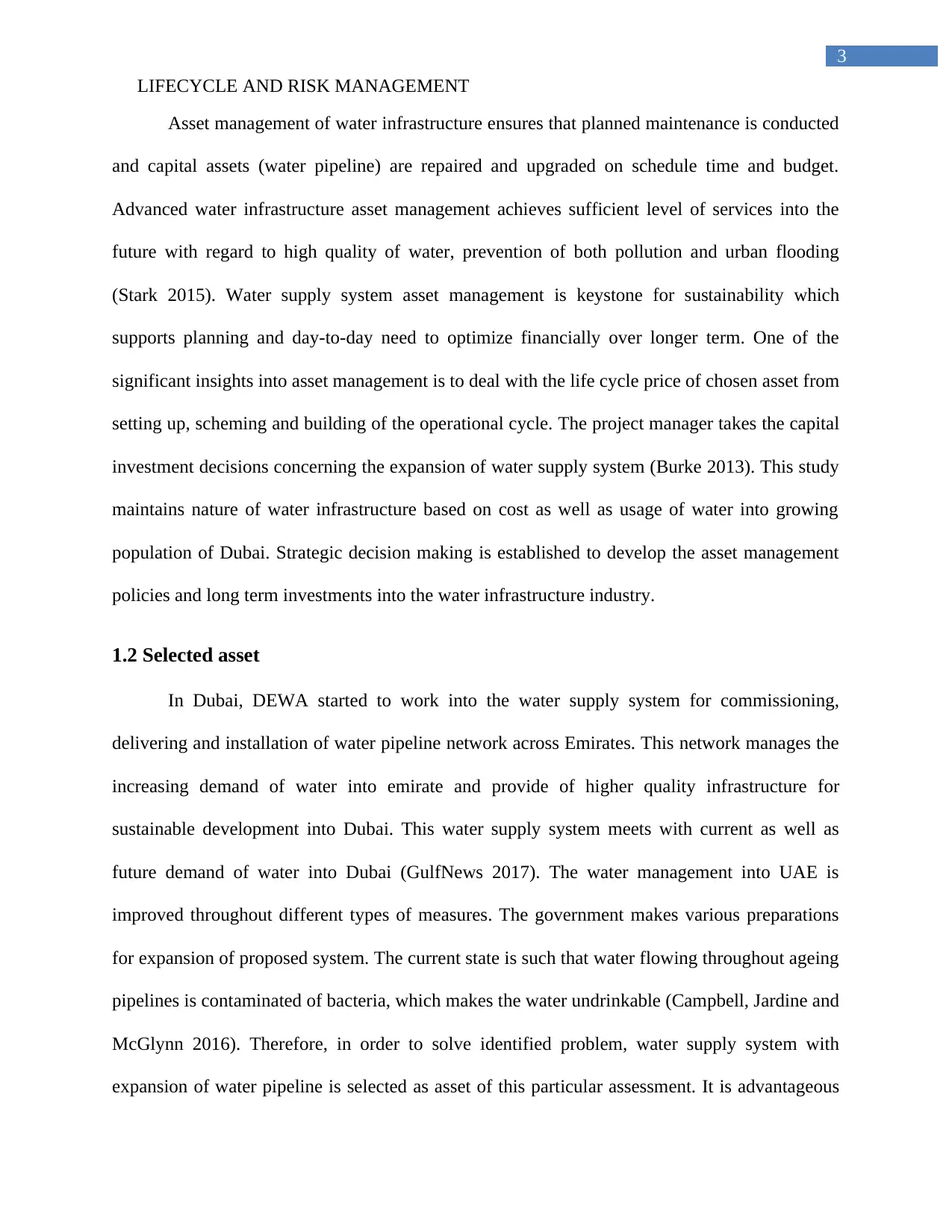
3
LIFECYCLE AND RISK MANAGEMENT
Asset management of water infrastructure ensures that planned maintenance is conducted
and capital assets (water pipeline) are repaired and upgraded on schedule time and budget.
Advanced water infrastructure asset management achieves sufficient level of services into the
future with regard to high quality of water, prevention of both pollution and urban flooding
(Stark 2015). Water supply system asset management is keystone for sustainability which
supports planning and day-to-day need to optimize financially over longer term. One of the
significant insights into asset management is to deal with the life cycle price of chosen asset from
setting up, scheming and building of the operational cycle. The project manager takes the capital
investment decisions concerning the expansion of water supply system (Burke 2013). This study
maintains nature of water infrastructure based on cost as well as usage of water into growing
population of Dubai. Strategic decision making is established to develop the asset management
policies and long term investments into the water infrastructure industry.
1.2 Selected asset
In Dubai, DEWA started to work into the water supply system for commissioning,
delivering and installation of water pipeline network across Emirates. This network manages the
increasing demand of water into emirate and provide of higher quality infrastructure for
sustainable development into Dubai. This water supply system meets with current as well as
future demand of water into Dubai (GulfNews 2017). The water management into UAE is
improved throughout different types of measures. The government makes various preparations
for expansion of proposed system. The current state is such that water flowing throughout ageing
pipelines is contaminated of bacteria, which makes the water undrinkable (Campbell, Jardine and
McGlynn 2016). Therefore, in order to solve identified problem, water supply system with
expansion of water pipeline is selected as asset of this particular assessment. It is advantageous
LIFECYCLE AND RISK MANAGEMENT
Asset management of water infrastructure ensures that planned maintenance is conducted
and capital assets (water pipeline) are repaired and upgraded on schedule time and budget.
Advanced water infrastructure asset management achieves sufficient level of services into the
future with regard to high quality of water, prevention of both pollution and urban flooding
(Stark 2015). Water supply system asset management is keystone for sustainability which
supports planning and day-to-day need to optimize financially over longer term. One of the
significant insights into asset management is to deal with the life cycle price of chosen asset from
setting up, scheming and building of the operational cycle. The project manager takes the capital
investment decisions concerning the expansion of water supply system (Burke 2013). This study
maintains nature of water infrastructure based on cost as well as usage of water into growing
population of Dubai. Strategic decision making is established to develop the asset management
policies and long term investments into the water infrastructure industry.
1.2 Selected asset
In Dubai, DEWA started to work into the water supply system for commissioning,
delivering and installation of water pipeline network across Emirates. This network manages the
increasing demand of water into emirate and provide of higher quality infrastructure for
sustainable development into Dubai. This water supply system meets with current as well as
future demand of water into Dubai (GulfNews 2017). The water management into UAE is
improved throughout different types of measures. The government makes various preparations
for expansion of proposed system. The current state is such that water flowing throughout ageing
pipelines is contaminated of bacteria, which makes the water undrinkable (Campbell, Jardine and
McGlynn 2016). Therefore, in order to solve identified problem, water supply system with
expansion of water pipeline is selected as asset of this particular assessment. It is advantageous
Paraphrase This Document
Need a fresh take? Get an instant paraphrase of this document with our AI Paraphraser
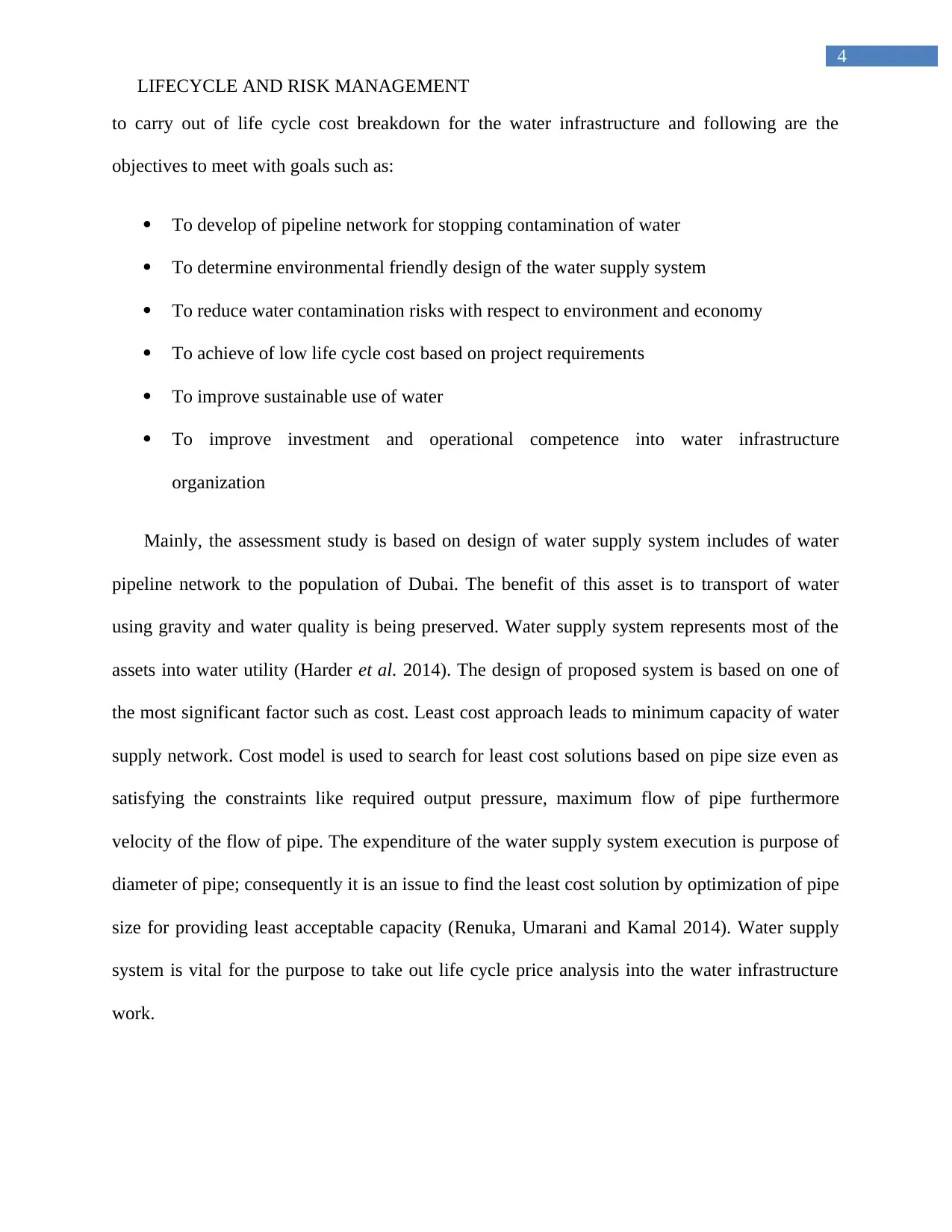
4
LIFECYCLE AND RISK MANAGEMENT
to carry out of life cycle cost breakdown for the water infrastructure and following are the
objectives to meet with goals such as:
To develop of pipeline network for stopping contamination of water
To determine environmental friendly design of the water supply system
To reduce water contamination risks with respect to environment and economy
To achieve of low life cycle cost based on project requirements
To improve sustainable use of water
To improve investment and operational competence into water infrastructure
organization
Mainly, the assessment study is based on design of water supply system includes of water
pipeline network to the population of Dubai. The benefit of this asset is to transport of water
using gravity and water quality is being preserved. Water supply system represents most of the
assets into water utility (Harder et al. 2014). The design of proposed system is based on one of
the most significant factor such as cost. Least cost approach leads to minimum capacity of water
supply network. Cost model is used to search for least cost solutions based on pipe size even as
satisfying the constraints like required output pressure, maximum flow of pipe furthermore
velocity of the flow of pipe. The expenditure of the water supply system execution is purpose of
diameter of pipe; consequently it is an issue to find the least cost solution by optimization of pipe
size for providing least acceptable capacity (Renuka, Umarani and Kamal 2014). Water supply
system is vital for the purpose to take out life cycle price analysis into the water infrastructure
work.
LIFECYCLE AND RISK MANAGEMENT
to carry out of life cycle cost breakdown for the water infrastructure and following are the
objectives to meet with goals such as:
To develop of pipeline network for stopping contamination of water
To determine environmental friendly design of the water supply system
To reduce water contamination risks with respect to environment and economy
To achieve of low life cycle cost based on project requirements
To improve sustainable use of water
To improve investment and operational competence into water infrastructure
organization
Mainly, the assessment study is based on design of water supply system includes of water
pipeline network to the population of Dubai. The benefit of this asset is to transport of water
using gravity and water quality is being preserved. Water supply system represents most of the
assets into water utility (Harder et al. 2014). The design of proposed system is based on one of
the most significant factor such as cost. Least cost approach leads to minimum capacity of water
supply network. Cost model is used to search for least cost solutions based on pipe size even as
satisfying the constraints like required output pressure, maximum flow of pipe furthermore
velocity of the flow of pipe. The expenditure of the water supply system execution is purpose of
diameter of pipe; consequently it is an issue to find the least cost solution by optimization of pipe
size for providing least acceptable capacity (Renuka, Umarani and Kamal 2014). Water supply
system is vital for the purpose to take out life cycle price analysis into the water infrastructure
work.
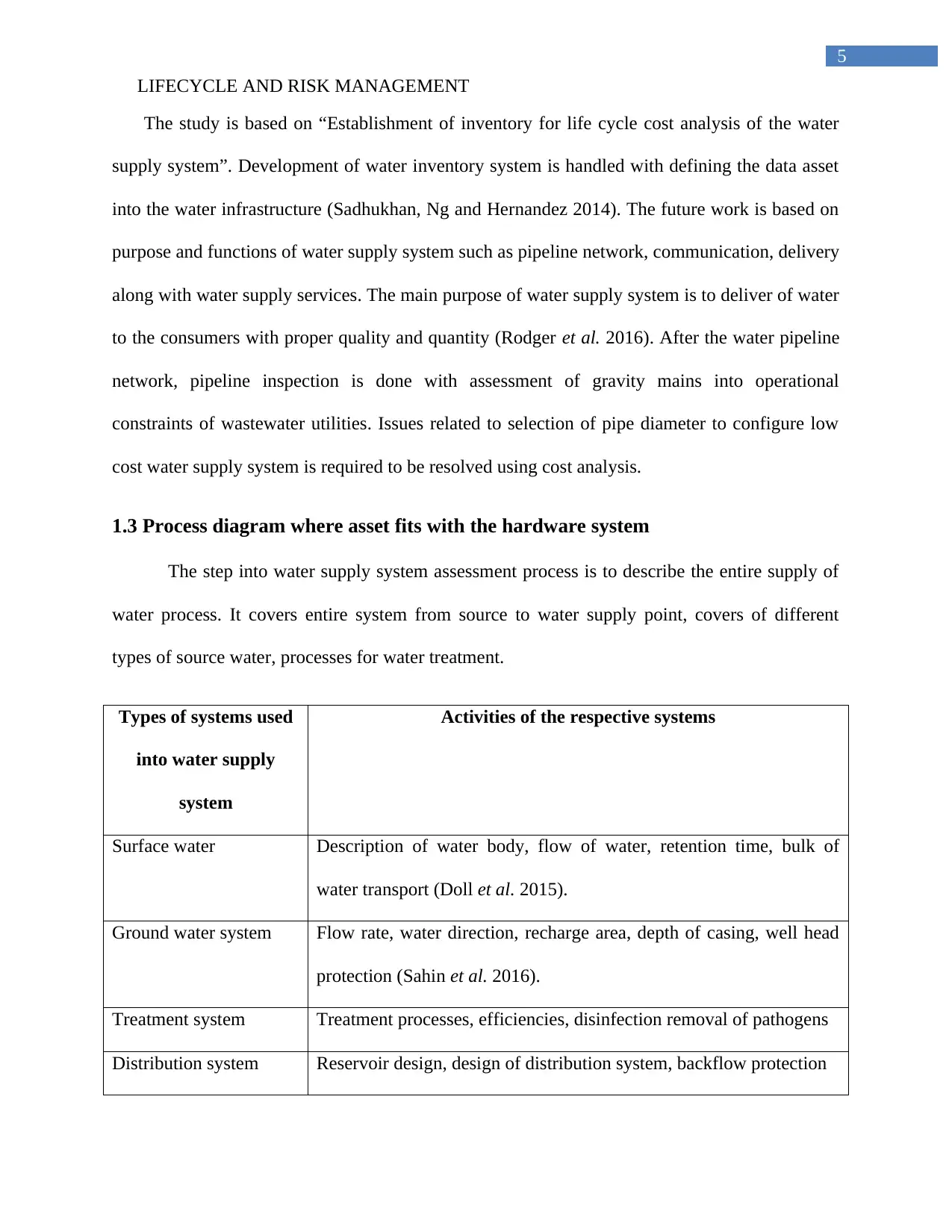
5
LIFECYCLE AND RISK MANAGEMENT
The study is based on “Establishment of inventory for life cycle cost analysis of the water
supply system”. Development of water inventory system is handled with defining the data asset
into the water infrastructure (Sadhukhan, Ng and Hernandez 2014). The future work is based on
purpose and functions of water supply system such as pipeline network, communication, delivery
along with water supply services. The main purpose of water supply system is to deliver of water
to the consumers with proper quality and quantity (Rodger et al. 2016). After the water pipeline
network, pipeline inspection is done with assessment of gravity mains into operational
constraints of wastewater utilities. Issues related to selection of pipe diameter to configure low
cost water supply system is required to be resolved using cost analysis.
1.3 Process diagram where asset fits with the hardware system
The step into water supply system assessment process is to describe the entire supply of
water process. It covers entire system from source to water supply point, covers of different
types of source water, processes for water treatment.
Types of systems used
into water supply
system
Activities of the respective systems
Surface water Description of water body, flow of water, retention time, bulk of
water transport (Doll et al. 2015).
Ground water system Flow rate, water direction, recharge area, depth of casing, well head
protection (Sahin et al. 2016).
Treatment system Treatment processes, efficiencies, disinfection removal of pathogens
Distribution system Reservoir design, design of distribution system, backflow protection
LIFECYCLE AND RISK MANAGEMENT
The study is based on “Establishment of inventory for life cycle cost analysis of the water
supply system”. Development of water inventory system is handled with defining the data asset
into the water infrastructure (Sadhukhan, Ng and Hernandez 2014). The future work is based on
purpose and functions of water supply system such as pipeline network, communication, delivery
along with water supply services. The main purpose of water supply system is to deliver of water
to the consumers with proper quality and quantity (Rodger et al. 2016). After the water pipeline
network, pipeline inspection is done with assessment of gravity mains into operational
constraints of wastewater utilities. Issues related to selection of pipe diameter to configure low
cost water supply system is required to be resolved using cost analysis.
1.3 Process diagram where asset fits with the hardware system
The step into water supply system assessment process is to describe the entire supply of
water process. It covers entire system from source to water supply point, covers of different
types of source water, processes for water treatment.
Types of systems used
into water supply
system
Activities of the respective systems
Surface water Description of water body, flow of water, retention time, bulk of
water transport (Doll et al. 2015).
Ground water system Flow rate, water direction, recharge area, depth of casing, well head
protection (Sahin et al. 2016).
Treatment system Treatment processes, efficiencies, disinfection removal of pathogens
Distribution system Reservoir design, design of distribution system, backflow protection
⊘ This is a preview!⊘
Do you want full access?
Subscribe today to unlock all pages.

Trusted by 1+ million students worldwide
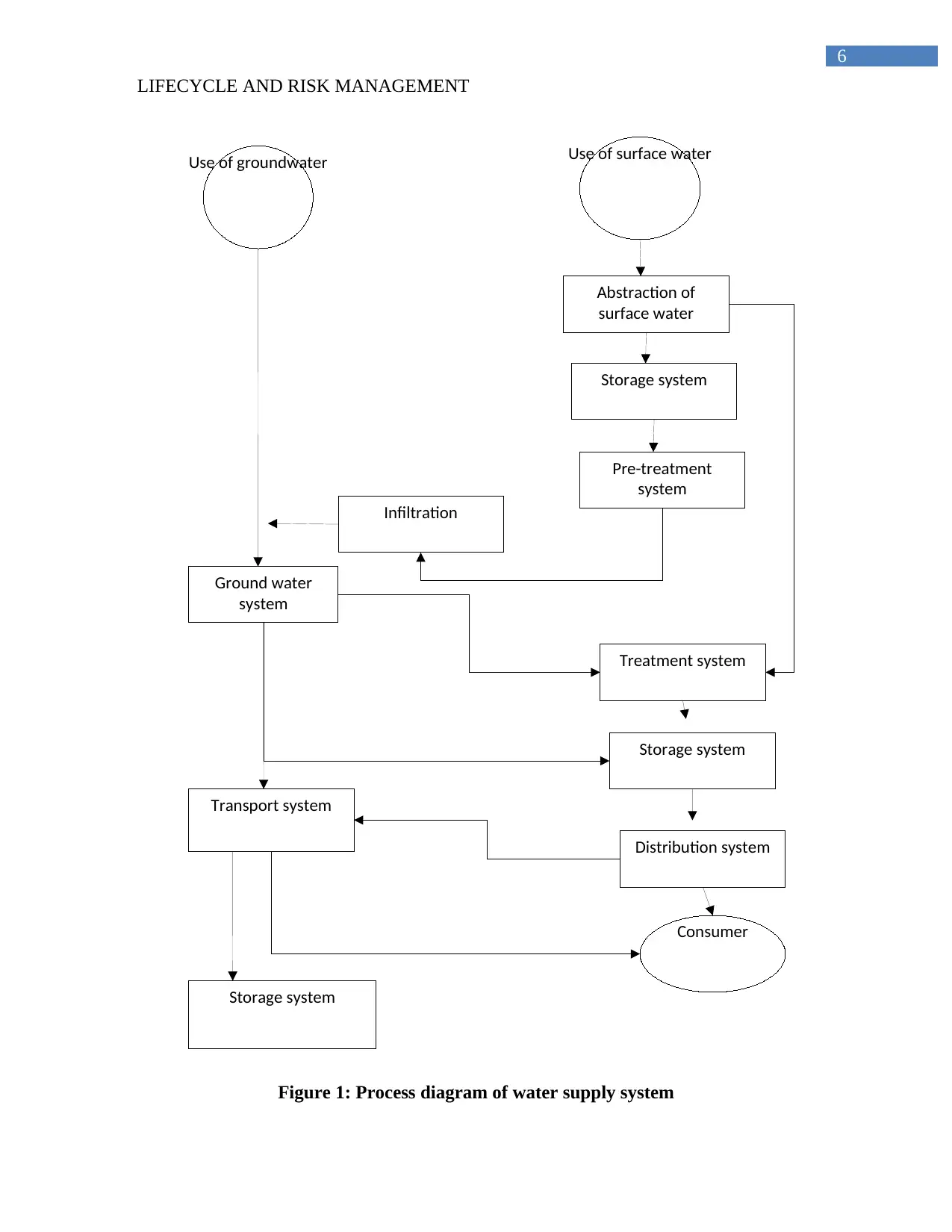
6
LIFECYCLE AND RISK MANAGEMENT
Use of groundwater Use of surface water
Abstraction of
surface water
Storage system
Pre-treatment
system
Infiltration
Treatment system
Storage system
Distribution system
Ground water
system
Consumer
Transport system
Storage system
Figure 1: Process diagram of water supply system
LIFECYCLE AND RISK MANAGEMENT
Use of groundwater Use of surface water
Abstraction of
surface water
Storage system
Pre-treatment
system
Infiltration
Treatment system
Storage system
Distribution system
Ground water
system
Consumer
Transport system
Storage system
Figure 1: Process diagram of water supply system
Paraphrase This Document
Need a fresh take? Get an instant paraphrase of this document with our AI Paraphraser

7
LIFECYCLE AND RISK MANAGEMENT
(Source: Scholten et al. 2015, pp-259)
2.0 Identifying an approach of life cycle cost analysis
In order to conclude on environmental friendly plan of the water supply system, life cycle
cost (LCC) analysis is being passed out for creating inventory of the materials as well as energy.
This particular study is carried out for different variables regards to water consumption and
linked to ecological impact of the planned system (Clay and Fong 2013). This assessment is
approached concept of the inventory development for purpose of the LCC analysis. Based on
some of the procedures, LCC is done for enabling management to know and direct of the water
supply system. LCC analysis is functional on number of water supply system to give consistent
information to the manager for making decisions related to asset management issues.
2.1 Lifecycle standards and approach selection
Pikaar et al. (2014) determined that implementation of asset management system needs
investment of time and cost into the industry. The life cycle standards is established by ISO
55000 certification. This particular standard formulates that asset management gives value to the
customers and project manager. With establishment of water supply system, value of asset is
realized to the stakeholders. ISO 55001 standards is provided with asset management decision
regarding development of water pipeline network when the decisions are best for managing
selected asset into the project work (Sahin, Stewart and Porter 2015). The project management
team determines proper design and operation of the water supply system. In order to analyze the
life cycle costing of this particular project work, Net Present Value is used by the industry. The
benefits of ISO 55001 asset management standards are as follows:
LIFECYCLE AND RISK MANAGEMENT
(Source: Scholten et al. 2015, pp-259)
2.0 Identifying an approach of life cycle cost analysis
In order to conclude on environmental friendly plan of the water supply system, life cycle
cost (LCC) analysis is being passed out for creating inventory of the materials as well as energy.
This particular study is carried out for different variables regards to water consumption and
linked to ecological impact of the planned system (Clay and Fong 2013). This assessment is
approached concept of the inventory development for purpose of the LCC analysis. Based on
some of the procedures, LCC is done for enabling management to know and direct of the water
supply system. LCC analysis is functional on number of water supply system to give consistent
information to the manager for making decisions related to asset management issues.
2.1 Lifecycle standards and approach selection
Pikaar et al. (2014) determined that implementation of asset management system needs
investment of time and cost into the industry. The life cycle standards is established by ISO
55000 certification. This particular standard formulates that asset management gives value to the
customers and project manager. With establishment of water supply system, value of asset is
realized to the stakeholders. ISO 55001 standards is provided with asset management decision
regarding development of water pipeline network when the decisions are best for managing
selected asset into the project work (Sahin, Stewart and Porter 2015). The project management
team determines proper design and operation of the water supply system. In order to analyze the
life cycle costing of this particular project work, Net Present Value is used by the industry. The
benefits of ISO 55001 asset management standards are as follows:
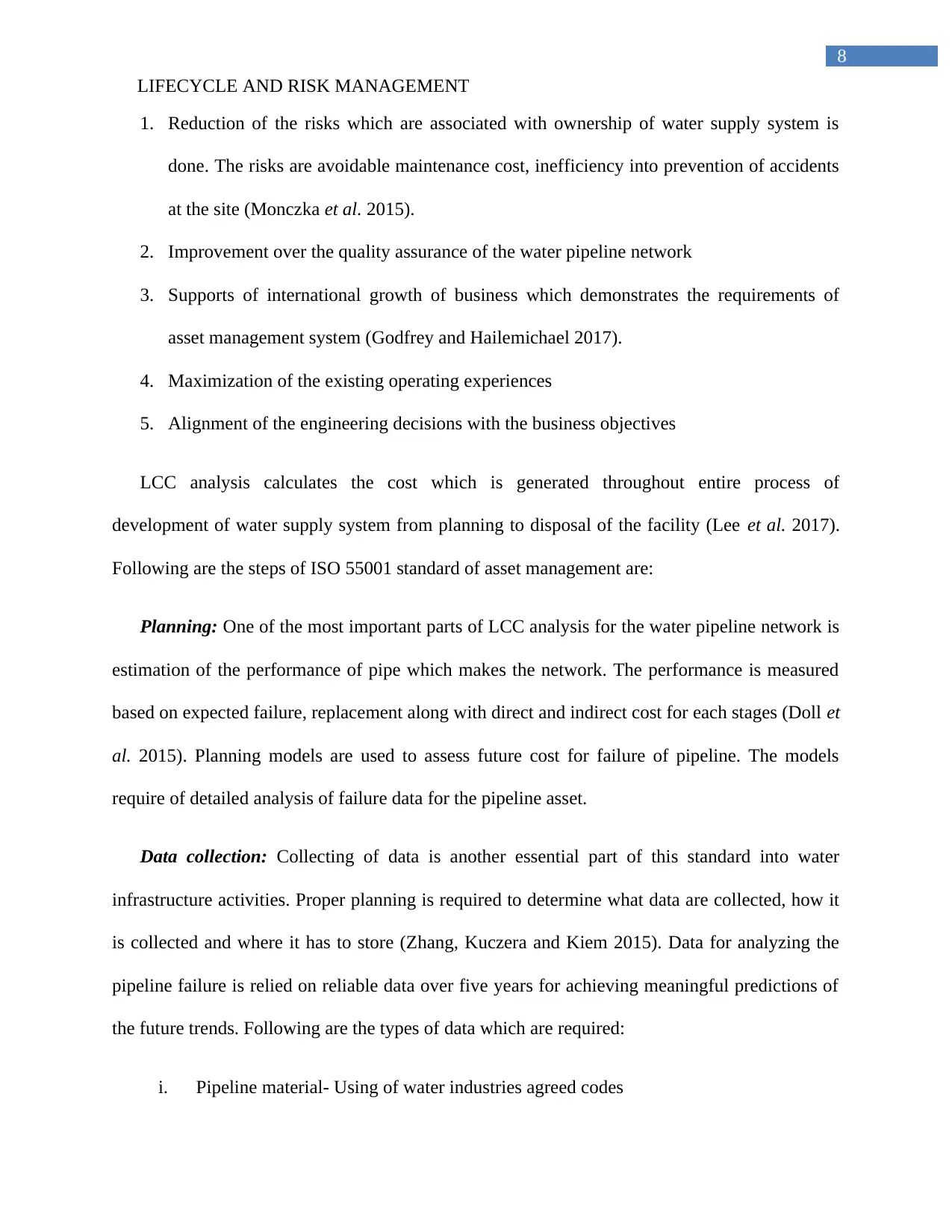
8
LIFECYCLE AND RISK MANAGEMENT
1. Reduction of the risks which are associated with ownership of water supply system is
done. The risks are avoidable maintenance cost, inefficiency into prevention of accidents
at the site (Monczka et al. 2015).
2. Improvement over the quality assurance of the water pipeline network
3. Supports of international growth of business which demonstrates the requirements of
asset management system (Godfrey and Hailemichael 2017).
4. Maximization of the existing operating experiences
5. Alignment of the engineering decisions with the business objectives
LCC analysis calculates the cost which is generated throughout entire process of
development of water supply system from planning to disposal of the facility (Lee et al. 2017).
Following are the steps of ISO 55001 standard of asset management are:
Planning: One of the most important parts of LCC analysis for the water pipeline network is
estimation of the performance of pipe which makes the network. The performance is measured
based on expected failure, replacement along with direct and indirect cost for each stages (Doll et
al. 2015). Planning models are used to assess future cost for failure of pipeline. The models
require of detailed analysis of failure data for the pipeline asset.
Data collection: Collecting of data is another essential part of this standard into water
infrastructure activities. Proper planning is required to determine what data are collected, how it
is collected and where it has to store (Zhang, Kuczera and Kiem 2015). Data for analyzing the
pipeline failure is relied on reliable data over five years for achieving meaningful predictions of
the future trends. Following are the types of data which are required:
i. Pipeline material- Using of water industries agreed codes
LIFECYCLE AND RISK MANAGEMENT
1. Reduction of the risks which are associated with ownership of water supply system is
done. The risks are avoidable maintenance cost, inefficiency into prevention of accidents
at the site (Monczka et al. 2015).
2. Improvement over the quality assurance of the water pipeline network
3. Supports of international growth of business which demonstrates the requirements of
asset management system (Godfrey and Hailemichael 2017).
4. Maximization of the existing operating experiences
5. Alignment of the engineering decisions with the business objectives
LCC analysis calculates the cost which is generated throughout entire process of
development of water supply system from planning to disposal of the facility (Lee et al. 2017).
Following are the steps of ISO 55001 standard of asset management are:
Planning: One of the most important parts of LCC analysis for the water pipeline network is
estimation of the performance of pipe which makes the network. The performance is measured
based on expected failure, replacement along with direct and indirect cost for each stages (Doll et
al. 2015). Planning models are used to assess future cost for failure of pipeline. The models
require of detailed analysis of failure data for the pipeline asset.
Data collection: Collecting of data is another essential part of this standard into water
infrastructure activities. Proper planning is required to determine what data are collected, how it
is collected and where it has to store (Zhang, Kuczera and Kiem 2015). Data for analyzing the
pipeline failure is relied on reliable data over five years for achieving meaningful predictions of
the future trends. Following are the types of data which are required:
i. Pipeline material- Using of water industries agreed codes
⊘ This is a preview!⊘
Do you want full access?
Subscribe today to unlock all pages.

Trusted by 1+ million students worldwide

9
LIFECYCLE AND RISK MANAGEMENT
ii. Installation of data- It should provide the year of installation
iii. Pipeline location- Town and zip code are required and what type of pipe is buried
under the road (Lee et al. 2017).
iv. Data related to soil- Again, there is use of industry standard codes to get the
information on soil type
v. Failure data- After occurrence of failure into the pipeline, then some set of data is
needed such as what type of failure, when it occurs and what are possible actions
should be taken to overcome the failure (Stenström et al. 2017).
Acquisition: Expansion of water pipeline network requires a significant capital
investment. Due to expansion of the network, there is needed to meet current standards which
increase both design, operational and examination cost of the project (Scholten et al. 2015).
Those changes lead to additional scope into the asset due to new upgradation of water pipeline
network.
Operation: The operational cost of the system is estimated using LCC analysis of
network (LICAN) model. The users are required to determine installation cost, repair and also
pipe replacement cost into the water network varied on size and set of time frame for the analysis
(Fletcher et al. 2017). This proposed model includes of cost for water loss. Output of this model
includes of tables, charts for comparing the alternatives, characteristics of water pipeline network
and summarizing the pipeline materials based on length, size and initial cost for water supply
system. The approach to LICAN model is to forecast the annual probability of failure for each
size of pipe based on length of pipe (Asefa, Adams and Kajtezovic-Blankenship 2014). For each
of the pipeline segment, expected probability of failure into the pipe is estimated for each year
LIFECYCLE AND RISK MANAGEMENT
ii. Installation of data- It should provide the year of installation
iii. Pipeline location- Town and zip code are required and what type of pipe is buried
under the road (Lee et al. 2017).
iv. Data related to soil- Again, there is use of industry standard codes to get the
information on soil type
v. Failure data- After occurrence of failure into the pipeline, then some set of data is
needed such as what type of failure, when it occurs and what are possible actions
should be taken to overcome the failure (Stenström et al. 2017).
Acquisition: Expansion of water pipeline network requires a significant capital
investment. Due to expansion of the network, there is needed to meet current standards which
increase both design, operational and examination cost of the project (Scholten et al. 2015).
Those changes lead to additional scope into the asset due to new upgradation of water pipeline
network.
Operation: The operational cost of the system is estimated using LCC analysis of
network (LICAN) model. The users are required to determine installation cost, repair and also
pipe replacement cost into the water network varied on size and set of time frame for the analysis
(Fletcher et al. 2017). This proposed model includes of cost for water loss. Output of this model
includes of tables, charts for comparing the alternatives, characteristics of water pipeline network
and summarizing the pipeline materials based on length, size and initial cost for water supply
system. The approach to LICAN model is to forecast the annual probability of failure for each
size of pipe based on length of pipe (Asefa, Adams and Kajtezovic-Blankenship 2014). For each
of the pipeline segment, expected probability of failure into the pipe is estimated for each year
Paraphrase This Document
Need a fresh take? Get an instant paraphrase of this document with our AI Paraphraser
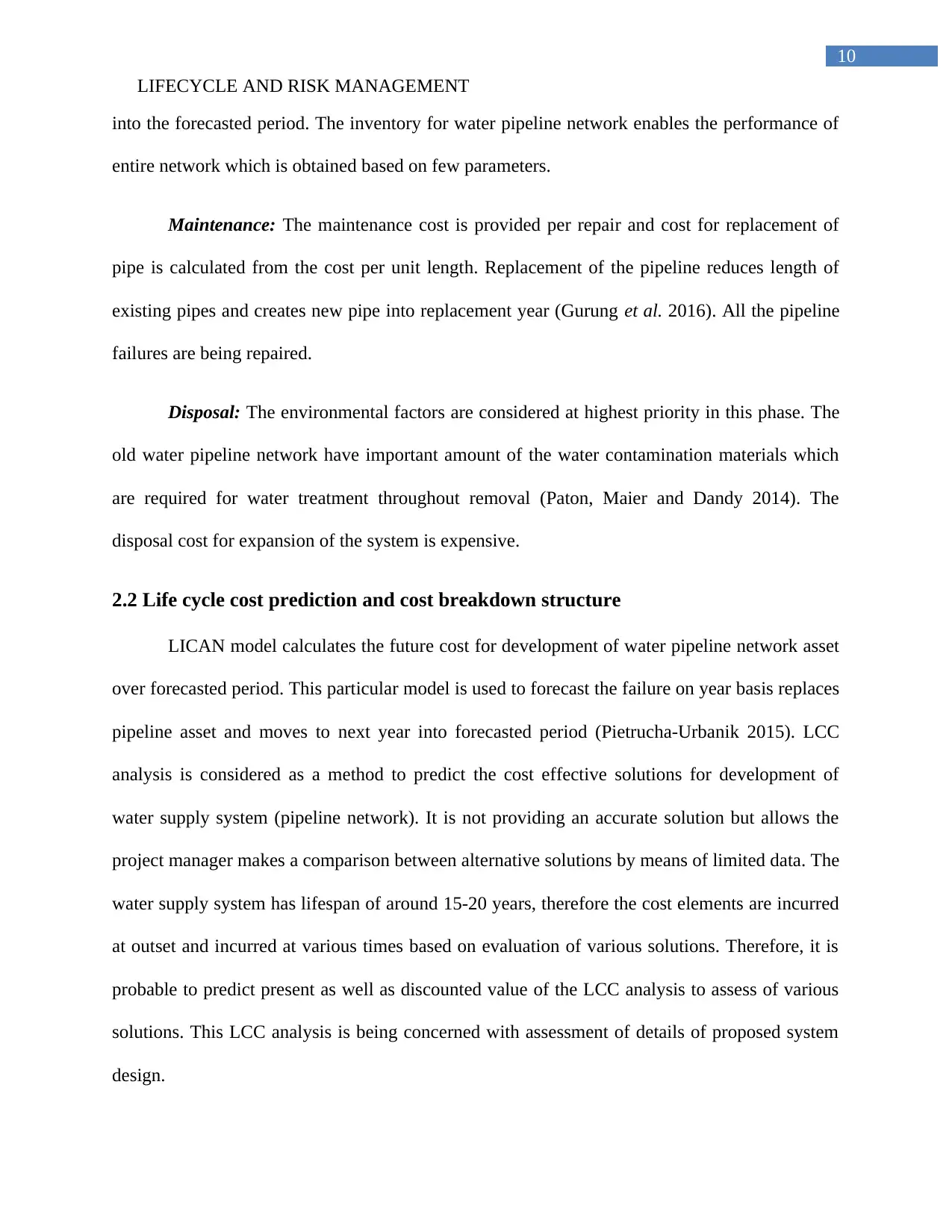
10
LIFECYCLE AND RISK MANAGEMENT
into the forecasted period. The inventory for water pipeline network enables the performance of
entire network which is obtained based on few parameters.
Maintenance: The maintenance cost is provided per repair and cost for replacement of
pipe is calculated from the cost per unit length. Replacement of the pipeline reduces length of
existing pipes and creates new pipe into replacement year (Gurung et al. 2016). All the pipeline
failures are being repaired.
Disposal: The environmental factors are considered at highest priority in this phase. The
old water pipeline network have important amount of the water contamination materials which
are required for water treatment throughout removal (Paton, Maier and Dandy 2014). The
disposal cost for expansion of the system is expensive.
2.2 Life cycle cost prediction and cost breakdown structure
LICAN model calculates the future cost for development of water pipeline network asset
over forecasted period. This particular model is used to forecast the failure on year basis replaces
pipeline asset and moves to next year into forecasted period (Pietrucha-Urbanik 2015). LCC
analysis is considered as a method to predict the cost effective solutions for development of
water supply system (pipeline network). It is not providing an accurate solution but allows the
project manager makes a comparison between alternative solutions by means of limited data. The
water supply system has lifespan of around 15-20 years, therefore the cost elements are incurred
at outset and incurred at various times based on evaluation of various solutions. Therefore, it is
probable to predict present as well as discounted value of the LCC analysis to assess of various
solutions. This LCC analysis is being concerned with assessment of details of proposed system
design.
LIFECYCLE AND RISK MANAGEMENT
into the forecasted period. The inventory for water pipeline network enables the performance of
entire network which is obtained based on few parameters.
Maintenance: The maintenance cost is provided per repair and cost for replacement of
pipe is calculated from the cost per unit length. Replacement of the pipeline reduces length of
existing pipes and creates new pipe into replacement year (Gurung et al. 2016). All the pipeline
failures are being repaired.
Disposal: The environmental factors are considered at highest priority in this phase. The
old water pipeline network have important amount of the water contamination materials which
are required for water treatment throughout removal (Paton, Maier and Dandy 2014). The
disposal cost for expansion of the system is expensive.
2.2 Life cycle cost prediction and cost breakdown structure
LICAN model calculates the future cost for development of water pipeline network asset
over forecasted period. This particular model is used to forecast the failure on year basis replaces
pipeline asset and moves to next year into forecasted period (Pietrucha-Urbanik 2015). LCC
analysis is considered as a method to predict the cost effective solutions for development of
water supply system (pipeline network). It is not providing an accurate solution but allows the
project manager makes a comparison between alternative solutions by means of limited data. The
water supply system has lifespan of around 15-20 years, therefore the cost elements are incurred
at outset and incurred at various times based on evaluation of various solutions. Therefore, it is
probable to predict present as well as discounted value of the LCC analysis to assess of various
solutions. This LCC analysis is being concerned with assessment of details of proposed system
design.

11
LIFECYCLE AND RISK MANAGEMENT
The project manager considered maintenance cost with initial supply of the equipments.
The elements of the LCC analysis are shown in the following table:
LCC= Cic + Cin + Ce + Co + Cm + Cs + Cenv + Cd
Where, LCC Life cycle cost
Cic Initial cost, cost for purchase of pump, pipeline, system
Cin Installation cost includes of training
Ce Energy cost includes of predicted cost for operation of system
Co Operation cost includes of labor cost for supervision of water supply system
Cm Maintenance and repair cost includes of predicted water system repairs
Cs Down time cost due to loss of production
Cenv Environmental cost includes of contamination from the pumped liquids
Cd Disposal cost includes of disposal of the auxiliary services
Table 1: Elements of the LCC analysis
(Source: Cuéllar-Franca and Azapagic 2014, pp-179)
Following are the costs which are forecasted for growth of water supply system are:
a. Installation cost- Throughout first period of the planning of selected asset, the installation
cost for asset is calculated as cost per foot linked with new material along with diameter
is being multiplied by length (Fuchs et al. 2014). LICAN model adds of pipeline asset
one at time for each of the material. It includes of set of the equipments, connection to
process pipe, connection to electrical wiring, performance evaluation and connection to
auxiliary system.
LIFECYCLE AND RISK MANAGEMENT
The project manager considered maintenance cost with initial supply of the equipments.
The elements of the LCC analysis are shown in the following table:
LCC= Cic + Cin + Ce + Co + Cm + Cs + Cenv + Cd
Where, LCC Life cycle cost
Cic Initial cost, cost for purchase of pump, pipeline, system
Cin Installation cost includes of training
Ce Energy cost includes of predicted cost for operation of system
Co Operation cost includes of labor cost for supervision of water supply system
Cm Maintenance and repair cost includes of predicted water system repairs
Cs Down time cost due to loss of production
Cenv Environmental cost includes of contamination from the pumped liquids
Cd Disposal cost includes of disposal of the auxiliary services
Table 1: Elements of the LCC analysis
(Source: Cuéllar-Franca and Azapagic 2014, pp-179)
Following are the costs which are forecasted for growth of water supply system are:
a. Installation cost- Throughout first period of the planning of selected asset, the installation
cost for asset is calculated as cost per foot linked with new material along with diameter
is being multiplied by length (Fuchs et al. 2014). LICAN model adds of pipeline asset
one at time for each of the material. It includes of set of the equipments, connection to
process pipe, connection to electrical wiring, performance evaluation and connection to
auxiliary system.
⊘ This is a preview!⊘
Do you want full access?
Subscribe today to unlock all pages.

Trusted by 1+ million students worldwide
1 out of 28
Related Documents
Your All-in-One AI-Powered Toolkit for Academic Success.
+13062052269
info@desklib.com
Available 24*7 on WhatsApp / Email
![[object Object]](/_next/static/media/star-bottom.7253800d.svg)
Unlock your academic potential
Copyright © 2020–2025 A2Z Services. All Rights Reserved. Developed and managed by ZUCOL.



